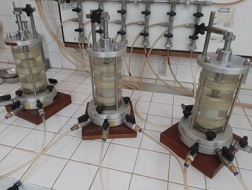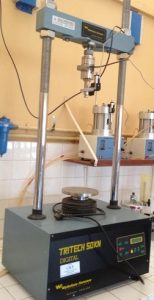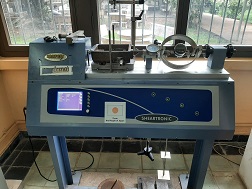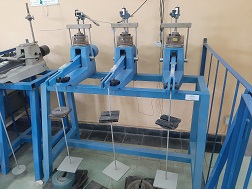Soil Mechanics Laboratory
Our Services
- Physical property: Moisture content, Specific Gravity, Grain size analysis, LL & PL, Classification of soil, FDT- by sand replacement (Sand Cone Method), core cutter method, MDD, OMC
- Mechanical property: Direct shear, tri-axial shear, uniaxial consolidation, UCS, CBR (soaked & unsoak), Field CBR
- Soil mix: Estimate the Soil-Lime Proportion, CBR, UCS
- GEOTECHNICAL INVESTIGATION: GCI-Lab has been providing various services towards Geotechnical Surveying, Hydrogeology Survey and other surveying services for some of the major companies towards their infrastructure and construction requirements. With its skilled manpower & advanced machinery at its disposal, GCI-Lab is one of the leading players providing In-situ tests and other geotechnical tests to a varied clients from various sectors including Infrastructure, Construction, Government Institutions, Industrial, etc.
Major Equipments
- Triaxial Test
Standard : BS 1377:7, 8 / ASTM D2850, D4767/ NF P94 070, P94 074
To design foundations, embankments and other soil structures, Geotechnical Engineers require methods of assessing the mechanical properties of soils (Mohr envelope: UU and CU test).
This machine has been designed for use both at field and in the laboratory where it is necessary to perform mechanical properties of soils. Compression tester, with 50kN max. capacity and lowest and highest speed corresponding to 0,00001 and 9,99999 mm per minute.


- Direct Shear Test
Standard : ASTM D3080, AASHTO T 236
Shear strength is defined as the resistance of a soil to the induced shear strain. Shear strength is not a fundamental property in soils as it depends on the in-situ conditions, such as density, moisture, stress state etc.
Shear Box apparatus is designed for carrying out tests on soil specimens of 60 mm and 20 mm high.
The strength parameters obtained from a direct shear test are the cohesion (c) and angle of friction (φ). In densely packed granular soils, two distinct values for these parameters exist, namely Peak or Maximum and Residual or Constant.

- One-Dimensional Consolidation Test
Standard : ASTM D2435, ASTM D4546, AASHTO T216, ASTM D3877, BS 1377-5
To Determine the magnitude and rate of consolidation of soil when it is restrained laterally and drained axially while subjected to incrementally applied controlled-stress loading.

- CBR Test
Standard : BS 1377, 1924; EN 13286-47; ASTM D1883; AASHTO T193
To determine the relative bearing ratio and expansion characteristics under known surcharge weight of base, subbase and sub grade soils for the design of roads, pavements and runways. The CBR test is used extensively in selection of materials and control of sub grades.



